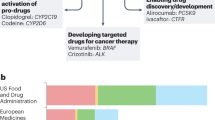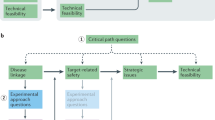Abstract
Heterogeneity in the underlying mechanisms of disease processes and inter-patient variability in drug responses are major challenges in drug development. To address these challenges, biomarker strategies based on a range of platforms, such as microarray gene-expression technologies, are increasingly being applied to elucidate these sources of variability and thereby potentially increase drug development success rates. With the aim of enhancing understanding of the regulatory significance of such biomarker data by regulators and sponsors, the US Food and Drug Administration initiated a programme in 2004 to allow sponsors to submit exploratory genomic data voluntarily, without immediate regulatory impact. In this article, a selection of case studies from the first 5 years of this programme — which is now known as the voluntary exploratory data submission programme, and also involves collaboration with the European Medicines Agency — are discussed, and general lessons are highlighted.
This is a preview of subscription content, access via your institution
Access options
Subscribe to this journal
Receive 12 print issues and online access
$209.00 per year
only $17.42 per issue
Buy this article
- Purchase on Springer Link
- Instant access to full article PDF
Prices may be subject to local taxes which are calculated during checkout






Similar content being viewed by others
References
Lesko, L. J. & Woodcock, J. Pharmacogenomic-guided drug development: regulatory perspective. Pharmacogenomics J. 2, 20–24 (2002).
Translation of pharmacogenomics and pharmacogenetics: a regulatory perspective. Nature Rev. Drug. Discov. 3, 763–769 (2004).
Goodsaid, F. & Frueh, F. W. Implementing the U. S. FDA guidance on pharmacogenomic data submissions. Environ. Mol. Mutagen. 48, 354–358 (2007).
Orr, M. S., Goodsaid, F., Amur, S., Rudman, A. & Frueh, F. W. The experience with voluntary genomic data submissions at the FDA and a vision for the future of the voluntary data submission program. Clin. Pharmacol. Ther. 81, 294–297 (2007).
US Food and Drug Administration, European Medicines Agency. Guiding principles processing joint FDA EMEA voluntary genomic data submissions (VGDSs) within the framework of the confidentiality arrangement. EMA website [online], (2006).
European Medicines Agency, Committee for Human Medicinal Products. Final report on the pilot EMEA/FDA VXDS experience on qualification of nephrotoxicity biomarkers. EMA website [online], (2008).
Hudes, G. et al. Temsirolimus, interferon alfa, or both for advanced renal-cell carcinoma. N. Engl. J. Med. 356, 2271–2281 (2007).
Twine, N. C. et al. Disease-associated expression profiles in peripheral blood mononuclear cells from patients with advanced renal cell carcinoma. Cancer Res. 63, 6069–6075 (2003).
Boni, J. et al. Population pharmacokinetics of CCI-779: correlations to safety and pharmacogenomic responses in patients with advanced renal cancer. Clin. Pharmacol. Ther. 77, 76–89 (2005).
Burczynski, M. E. et al. Transcriptional profiles in peripheral blood mononuclear cells prognostic of clinical outcomes in patients with advanced renal cell carcinoma. Clin. Cancer Res. 11, 1181–1189 (2005).
Burczynski, M. E. & Dorner, A. J. Transcriptional profiling of peripheral blood cells in clinical pharmacogenomic studies. Pharmacogenomics 7, 187–202 (2006).
Atkins, M. B. et al. Randomized phase II study of multiple dose levels of CCI-779, a novel mammalian target of rapamycin kinase inhibitor, in patients with advanced refractory renal cell carcinoma. J. Clin. Oncol. 22, 909–918 (2004).
Golub T. R. et al. Molecular classification of cancer: class discovery and class prediction by gene expression monitoring. Science 286, 531–537 (1999).
Shippy, R. et al. Using RNA sample titrations to assess microarray platform performance and normalization techniques. Nature Biotech. 24, 1123–1131 (2006).
Hill, A. A. et al. Evaluation of normalization procedures for oligonucleotide array data based on spiked cRNA controls. Genome Biol. 2, research0055.1–0055.13 (2001).
Canales, R. D. et al. Evaluation of DNA microarray results with quantitative gene expression platforms. Nature Biotech. 24, 1115–1122 (2006).
Sellar, G. et al. Opportunities posed by novel patient selection biomarker approaches in oncology drug development: going beyond the cytotoxics. Biomarkers Med. 2, 147–153 (2008).
Lavallie, E. R., Dorner, A. J., Burczynski, M. E. Use of ex vivo systems for biomarker discovery. Curr. Opin. Pharmacol. 8, 647–653 (2008).
DiBlasio-Smith, E. A. et al. Discovery and implementation of transcriptional biomarkers of synthetic LXR agonists in peripheral blood cells. J. Transl. Med. 6, 59 (2008).
US Department of Health and Human Services, Food and Drug Administration, Center for Drug Evaluation and Research, National Center for Toxicological Research, Center for Biologics Evaluation and Research, Center for Devices and Radiological Health. Guidance for Industry. Pharmacogenomic data submissions — companion guidance (draft guidance). FDA website [online], (2007).
Heggie, G. D., Sommadossi, J. P., Cross, D. S., Huster, W. J. & Diasio, R. B. Clinical pharmacokinetics of 5-fluorouracil and its metabolites in plasma, urine, and bile. Cancer Res. 47, 2203–2206 (1987).
Lu, Z., Zhang, R., Carpenter, J. T. & Diasio, R. B. Decreased dihydropyrimidine dehydrogenase activity in a population of patients with breast cancer: implication for 5-fluorouracil-based chemotherapy. Clin. Cancer Res. 4, 325–329 (1998).
Ezzeldin, H. H. & Diasio, R. B. Predicting fluorouracil toxicity: can we finally do it? J. Clin. Oncol. 26, 2080–2082 (2008).
van Kuilenburg, A. B. Dihydropyrimidine dehydrogenase and the efficacy and toxicity of 5-fluorouracil. Eur. J. Cancer 40, 939–950 (2004).
Wiviott, S. D. et al. Prasugrel versus clopidogrel in patients with acute coronary syndromes. N. Engl. J. Med. 357, 2001–2015 (2007).
Daly, T. M. et al. Multiplex assay for comprehensive genotyping of genes involved in drug metabolism, excretion, and transport. Clin. Chem. 53, 1222–1230 (2007).
Dumaual, C. et al. Comprehensive assessment of metabolic enzyme and transporter genes using the affymetrix targeted genotyping system. Pharmacogenomics 8, 293–305 (2007).
Mega, J. L. et al. Cytochrome P450 genetic polymorphisms and the response to prasugrel: relationship to pharmacokinetic, pharmacodynamic, and clinical outcomes. Circulation 119, 2553–2560 (2009).
Mega, J. L. et al. Cytochrome p-450 polymorphisms and response to clopidogrel. N. Engl. J. Med. 360, 354–362 (2009).
Varenhorst, C. et al. Genetic variation of CYP2C19 affects both pharmacokinetic and pharmacodynamic responses to clopidogrel but not prasugrel in aspirin-treated patients with coronary artery disease. Eur. Heart J. 30, 1744–1752 (2009).
Lee, W. M. et al. Hepatic findings in long-term clinical trials of ximelagatran. Drug Saf. 28, 351–370 (2005).
Harenberg, J., Jörg, I. & Weiss, C. Observations of alanine aminotransferase and aspartate aminotransferase in THRIVE studies treated orally with ximelagatran. Intl J. Toxicol. 25, 165–169 (2006).
AstraZeneca. AstraZeneca decides to withdraw Exanta. AstraZeneca website [online], (2006).
Kenne, K. et al. Prediction of drug-induced liver injury in humans by using in vitro methods: the case of ximelagatran. Toxicol. In Vitro 22, 730–746 (2008).
Kindmark, A. et al. Genome-wide pharmacogenetic investigation of a hepatic adverse event without clinical signs of immunopathology suggests an underlying immune pathogenesis. Pharmacogenomics J. 8, 186–195 (2008).
Andersson, U. et al. A systems biology approach to understanding elevated serum alanine transaminase levels in a clinical trial with ximelagatran. Biomarkers 14, 572–586 (2009).
Burckart, G. J. et al. Qualification of biomarkers for drug development in organ transplantation. Am. J. Transplant. 8, 267–270 (2008).
Jevnikar, A. M. & Mannon, R. B. Late kidney allograft loss: what we know about it, and what we can do about it. Clin. J. Am. Soc. Nephrol. 3, S56–S67 (2008).
Nankivell, B. J. & Chapman, J. R. Chronic allograft nephropathy: current concepts and future directions. Transplantation 81, 643–654 (2006).
Seron, D. & Moreso, F. Protocol biopsies in renal transplantation: prognostic value of structural monitoring. Kidney Int. 72, 690–697 (2007).
Cosio, F. et al. Kidney allograft fibrosis and atrophy early after living donor transplantation. Am. J. Transplant. 5, 1130–1136 (2005).
Scherer, A. et al. Early prognosis of the development of renal chronic allograft rejection by gene expression profiling of human protocol biopsies. Transplantation 75, 1323–1330 (2003).
US Department of Health and Human Services, Food and Drug Administration, Center for Devices and Radiological Health, Office of In Vitro Diagnostic Device Evaluation and Safety, Center for Biologic Evaluation and Research. Draft Guidance for Industry, Clinical Laboratories, and FDA Staff. In vitro diagnostic multivariate index assays. FDA website [online], (2007).
US Department of Health and Human Services, Food and Drug Administration, Center for Devices and Radiological Health, Office of In Vitro Diagnostic Device Evaluation and Safety, Division of Immunology and Hematology Devices. Guidance for Industry and FDA Staff. Class II special controls guidance document: gene expression profiling test system for breast cancer prognosis. FDA website [online], (2007).
Snyder, R. D. & Green, J. W. A review of the genotoxicity of marketed pharmaceuticals. Mutat. Res. 488, 151–169 (2001).
Aubrecht, J. & Caba, E. Gene expression profile analysis: an emerging approach to investigate mechanisms of genotoxicity. Pharmacogenomics 6, 419–428 (2005).
Guyton, K. Z. et al. Improving prediction of chemical carcinogenicity by considering multiple mechanisms and applying toxicogenomic approaches. Mutat. Res. 681, 230–240 (2009).
Amundson, S. A. et al. Stress-specific signatures: expression profiling of p53 wild-type and -null human cells. Oncogene 24, 4572–4579 (2005).
Henderson, L., Albertini, S. & Aardema, M. Thresholds in genotoxicity responses. Mutat. Res. 464, 123–128 (2000).
Kirsch-Volders, M., Vanhauwaert, A., Eichenlaub-Ritter, U. & Decordier, I. Indirect mechanisms of genotoxicity. Toxicol. Lett. 140–141, 63–74 (2003).
Food and Drug Administration. Guidance for Industry and Review Staff. Approaches to integration of genetic toxicology study results. FDA website [online], (2006).
Weinstein, D., Mauer, I., Katz, M. L. & Kazmer, S. The effect of methylxanthines on chromosomes of human lymphocytes in culture. Mutat. Res. 31, 57–61 (1975).
Author information
Authors and Affiliations
Corresponding author
Ethics declarations
Competing interests
Federico M. Goodsaid, Shashi Amur, Jiri Aubrecht, Jennifer Catalano, Rosane Charlab, Albert J. Fornace Jr, Huixiao Hong, David Jacobson-Kram, Ansar Jawaid, Lawrence Lesko, Heng-Hong Li, Klaus Lindpainter, Marisa Papaluca-Amati, Timothy W. Robison, Ina Schuppe-Koistinen, Leming Shi, Weida Tong, Li Zhang, and Issam Zineh declare no competing financial interests.
Michael E. Burczynski has none beyond previous employment by Wyeth and current employment by F. Hoffmann-La Roche.
Kevin Carl is an employee and shareholder of Novartis Pharmaceuticals Corporation.
Sandra Close is an employee and shareholder of Eli Lilly and Company.
Catherine Cornu-Artis is a full-time employee of Novartis Pharma AG, Switzerland.
Laurent Essioux is a full-time employee of F. Hoffmann-La Roche.
Lois Hinman is an employee of Novartis and shareholder of Novartis stock.
Ian Hunt is an employee of AstraZeneca.
David Laurie is a full-time employee of Novartis Pharma AG, Switzerland and a holder of shares in Novartis.
James Mayne has stocks in Pfizer, which participates in business activities that are regulated by the US FDA and the EMA.
Peter Morrow is an employee and shareholder of Eli Lilly and Company.
John Roth is a full-time employee of F. Hoffmann-La Roche.
Olivia Spleiss is a full-time employee of F. Hoffmann-La Roche.
Sharada L. Truter is a full-time employee and shareholder of Pfizer.
Jacky Vonderscher is a full-time employee and shareholder of F. Hoffmann-La Roche and also a shareholder of Novartis.
Agnes Westelinck has none beyond previous employment by F. Hoffmann-La Roche and current employment by GlaxoSmithKline.
Additional information
Disclaimer: Opinions, ideas and statements in this paper are presented at the sole discretion of the authors and do not necessarily represent those from each of the companies or agencies for which these authors work. No official endorsement or policy is intended nor should be inferred.
Related links
Related links
DATABASES
OMIM
FURTHER INFORMATION
Interdisciplinary Pharmacogenomics Review Group
Pharmacogenomics Working Party
Table of valid genomic biomarkers in the context of approved drug labels
Rights and permissions
About this article
Cite this article
Goodsaid, F., Amur, S., Aubrecht, J. et al. Voluntary exploratory data submissions to the US FDA and the EMA: experience and impact. Nat Rev Drug Discov 9, 435–445 (2010). https://doi.org/10.1038/nrd3116
Issue Date:
DOI: https://doi.org/10.1038/nrd3116
This article is cited by
-
Health regulatory communications of well-established safety-related pharmacogenomics associations in six developed countries: an evaluation of alignment
The Pharmacogenomics Journal (2017)
-
Pharmacogenetics in Cardiovascular Disorders: An Update on the Principal Drugs
American Journal of Cardiovascular Drugs (2013)



